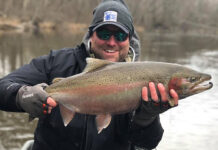Editor’s note: Do your own research before engaging in at-home chemistry experiments.
For over two years, we have produced our own soap from the fat of our pigs for practically nothing. We have purchased some fragrance oils, but mostly just to experiment with. In the end, the old-fashioned lard and lye soap has become the mainstay on our homestead.
Eventually, I started using the soap on my head, and then my wife tried. We no longer use any commercial hair products or other soaps, and we get much better cleaning and conditioning from the soap. This simple transition has saved our family thousands of dollars per year.
When I begin teaching the kids how to make soap, I start with a chemistry lesson. Chemistry is extremely important to understand how the ingredients of life form compounds and mixtures that we use every day. Looking at the periodic table of elements, there are trends of reactivity. Starting at the far-right side, moving left and downward towards francium, shows the least to most reactive elements. This means that elements on the left-hand side are far more reactive than those found on the right.
Fascinating as that may be, it’s time to make soap. Soap making is made possible by a chemistry reaction called saponification. The highly reactive substances used for this, commonly referred to as lye, are potassium hydroxide and/or sodium hydroxide. Since the latter is on the farthest left, it is more reactive. Furthermore, it is usually used for bar soap, while the former is used for liquid soaps or some mixture of the two.
The predominant type of soap that we use is a lard bar. The recipe consists of lard, lye and water. Many people use distilled water, but I prefer our well water. We have a softener, which is extremely important.
The softened water with a superfat soap recipe will leave you helplessly trying to get the soap off your body in the shower. Hard water and superfat soap go together much better. I discovered this after reading and experimenting with my recipe.
The sap value of lard is 0.138, meaning I need 138 grams of sodium hydroxide mixed with water for every 1,000 grams of lard. Before mixing, it’s important to get cold water. Although you can vary the amounts of water between 1 and 3 for the given amount of lye, I prefer somewhere around 2. So, I use 138 g sodium hydroxide, 276 g of cold water and 1,000 g of lard.
The first step is to add my own safety buffer by measuring a few grams shy of my goal and then pour it into the water and mix. The cold water quickly gets hot, exceeding 100 degrees, because of its highly reactive nature. This is why you start with cold water. If there is any lye that remains unreacted, it can burn you and cause serious injury, hence why I keep a bowl full of vinegar on hand the entire time — to neutralize the lye if it starts to burn.
I forgot to mention that you want to do this with goggles, mask, gloves and good ventilation, because this is about the time that I realize that I don’t have these things.
Quickly donning the appropriate safety gear and mixing outside, we wait for the temperature of the lye and water mixture to cool down. Then, when the lard and lye solution are around the same temperature, we add the lye to the fat and mix.
You must mix for an extended period of time to get everything together. For this, I prefer an immersion blender. Mix for several minutes and then off and on for 30 seconds or so until it gets to a pudding consistency, called tracing.
At this stage, you can add essential oils for fragrance or anything else. If you added fragrance oil earlier, it could get turned into soap. Then it’s time to pour into a mold. I use a silicone bar soap mold as well as silicone cupcake mold that are easy to turn out. Within 12 hours, they must be sliced or they become too hard. Finally, the soap must sit to cure for a few weeks before it can be used.
In an attempt to speed the curing process up, I started running batches in the dehydrator at very low heat and checking pH for doneness. The final pH must be slightly basic but not too strong. Initially, my bars are between 10-11, and after curing or dehydrating, the final pH is between 8-9.1. Perfect!
(Eric Keller is a veteran, husband, proud father of four, nurse and first-generation homesteader who can be reached at happyrootshomesteadohio@gmail.com.)













